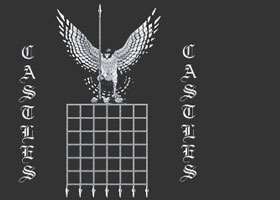And appropriate skills were developed to fulfil these needs relating to Interior Castle design. Wooden castles were replaced with stone castles. The interiors were improved. Time moved on and the Normans were replaced by the Plantagenets. Gone were the cold, dark and damp castles of the Norman era - the Plantagenet rulers were looking for Middle Age refinement and luxury! - The Medieval era saw improved tools such as the chisel, as opposed to axes, which led to more decorative designs and tracery skills reflected in the Medieval Castle Interiors
- Plumbing improved and lead was often used for the gutters
- Wainscoting was introduced - wooden panels were used to line the walls of a room replacing the whitewash of previous castle interiors
- Medieval Artists were employed - wall paintings covered the walls above the wainscoting. Art had come to Medieval castle interiors!
- Medieval Castle interiors were highly colourful - gold paint was a luxurious item which was used in vast quantities!
- Fireplaces were a necessary feature of Medieval Castle Building and chimneys were introduced replacing the central hearths with canopies and escape louvres in the roof
- Thatching was still used for roofs but stone slates, tiling and plastered straw was introduced to reduce the risk of fire
- Additional interior staircases were introduced - many for the private use of the Lords of the castle
- Windows were much bigger, due to the introduction of the pointed arch which could support greater weight, allowing the walls of the Medieval Castle to be thinner with wider window openings
- Panes of glass were added, replacing horn or wooden shutters, and the interior of the castle became lighter and airier
- Glass windows were often painted with armorial designs - more interior design features!
- Kitchens were integrated into the Medieval stone castle - they included cooking ovens for baking and huge fireplaces for smoking and roasting food. They also had a water supply complete with a sink and drainage
- Cleanliness improved and lavers ( stone basins used for washing ) were provided at the entrances of the dining halls
- Bathing was usually conducted in wooden barrels but simply designed bathrooms were added in Medieval Castle interiors for the Lords
- There were many lavatories, called garderobes or privies, included in Medieval Castle interiors. The Privy chambers were positioned as far away from the interior chambers as practical and often had double doors added to reduce the smell! Chutes were provided for the discharge which often led to the castle moat. Privy seats were made of wood or stone
- A limited number of Carpets and mats were introduced to castle interiors but floors strewed with straw or rushes were still favoured. Sweet smelling herbs such as lavender, camomile, rose petals, daisies and fennel were added to disguise the bad smells of the castles which were prevalent due to the inadequate plumbing systems
- Lighting - Three types of methods were used to light the interiors of Medieval castles
- Rush Dips - These were tapers made out of the stalks of rushes which had been dipped in melted fat and then dried. The rush dip was then placed into a receptacle called a 'Nip'. It provided a weak light which lasted about half and hour
- Candles - candles were home made from animal fat. Placed in candle sticks they lasted longer than the rush dips
- Torches - Torches were used to light the interiors of large areas such as the Great Hall
- Lanterns - or 'lanthorns'. A candle was stuck into a metal frame with sides made of thin, transparent horns
Medieval Castle InteriorsMedieval Castle Interiors - Medieval Castle Interiors - the plumbing!
- Medieval Castle Interiors - the heating!
- Medieval Castle Interiors - the lighting!
- Medieval Castle Interiors - the floor covering!
- Medieval Castle Interiors - artistic design!
Medieval Castle Interiors
Medieval castle interiors were designed to make castle life more comfortable. The Lords rooms also had the benefit of castle furniture. For more details of Medieval Castle interiors refer to the sections about the Rooms in the Medieval Castle
Medieval Castle Furniture |

